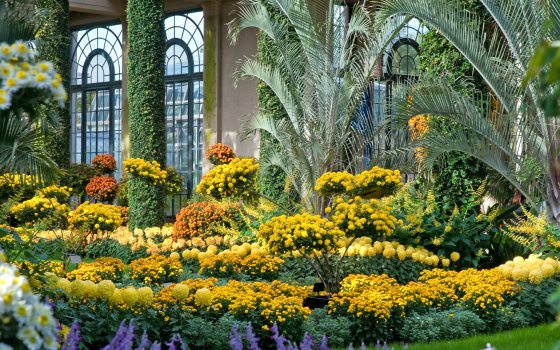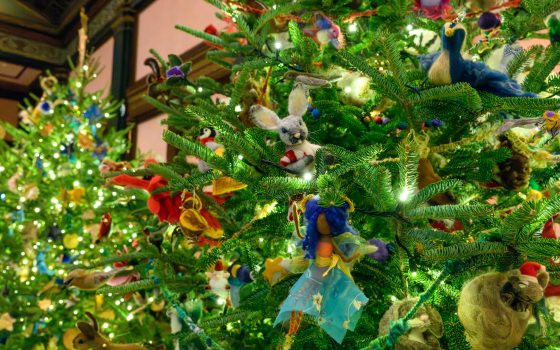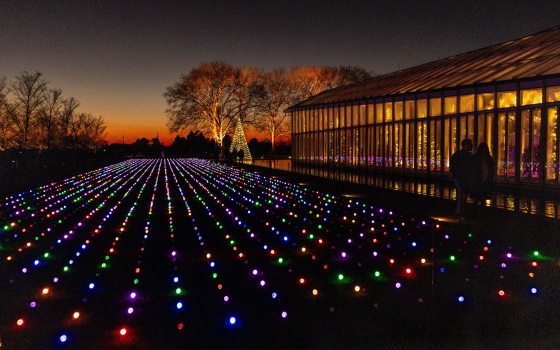As Longwood’s Display Designer, it is my responsibility to make sure that our Chrysanthemum Festival is beautiful and engaging. In order to make the Festival successful we rely on a very talented group of individuals, and it is my privilege to lead the creative process. The plans for Chrysanthemum Festival happen more than one year in advance, starting with my conceptual plan that takes into account color, height, texture, and other aesthetic considerations. This plan is dependent upon our amazing horticulturists who produce exhibition-style mums in extraordinary ways, topping themselves year after year.
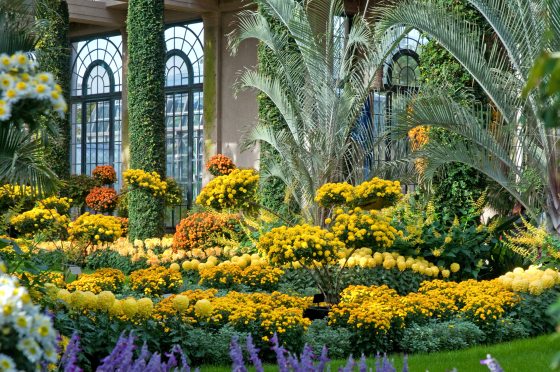
The exhibition-style mums that we grow shouldn’t be confused with regular garden mums or hardy outdoor mums. Our mums require a lot of attention, including greenhouse growing, staking, tying, spraying, and maintaining stock plants. Chrysanthemum Festival is horticulturally the most challenging exhibition we present every year, and its success is credited to our wonderful and diligent production team.
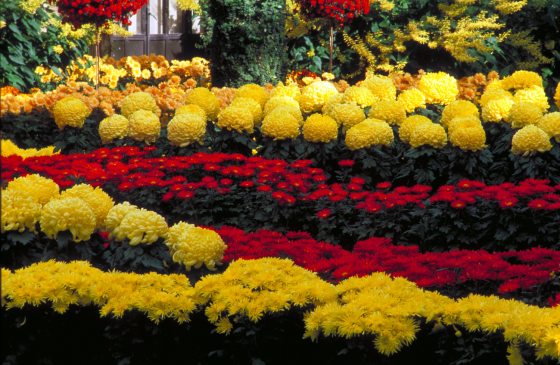
Chrysanthemum Festival is a distinct “season” in the Conservatory, when the Orangery, Exhibition Hall, and East Conservatory go through a nearly complete transformation to fill the beds with mums and plenty of fall color. I generally think of the display in the “traditional” autumnal shades of reds, oranges, and yellows, but I always try to also include pink, purple, and white chrysanthemums. Even though these are not traditional fall colors they offer beautiful flower forms. I also keep in the back of my mind that I want the festival to incorporate Asian aesthetic touches, especially with some of the traditional forms that we grow, since mums are native to Japan and China.
Every mum starts its life as a cutting. These cuttings may have come from a stock plant (a plant from which we take cuttings in order to propagate other plants) or may have been grown out of an extensive tissue culture holding (tissue culture is a process of collecting and freezing samples of plants for later growth). After developing roots, these young plants are potted in mid- to late-summer, depending on when they are scheduled to bloom. We have collected thorough data on how each cultivar grows and performs so that we can calculate exactly when to make the cutting and start a new plant in order to get a perfectly timed bloom each fall.
Some cultivars are scheduled to be “single stems,” which means our growers plant one cutting per pot, then stake and tie the plant as it grows to its full height, while pinching off side buds so that the plant ultimately produces one large terminal bud that is allowed to flower. This technique encourages the plant to send all of its energy into the terminal bud, producing the largest flower possible for that cultivar. The second style of mum we use in the display is known as a “disbud.” This means that five cuttings are placed in a pot. These cuttings are then pinched (removing side buds) so that each cutting ends up with only three blooms each, for a total of fifteen blooms per pot. This will produce a large-to-medium size flower, depending on the cultivar. The mum grown with the least amount of work is a spray style mum. These, again, have five cuttings in a pot but are allowed to maintain all or almost all their buds, creating a full-flower effect of smaller blooms.
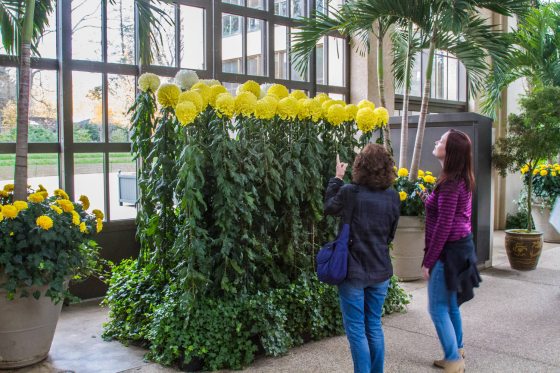
I think it makes for a more interesting display if I can incorporate all three styles of the exhibition mums in different cultivars on each walkway in the Orangery and Exhibition Hall. This allows for three different flower sizes and large sweeps of each to create interest in the design. The chrysanthemums are often complemented with foliage plants to highlight the flowers.
Today’s chrysanthemums are highly evolved flowering plants divided into 13 classifications based on their flower form. One of the most recognized forms is the irregular incurve, known more commonly as the football mum. In the floral industry, the decorative, pompon, daisy, and spider are some of the more common types seen in floral arrangements. Each year while planning the display, I consciously try to use each classification. Guests can get a primer on the 13 classifications by visiting our Fern Passage, where we showcase an example of each with signage to identify the plants.
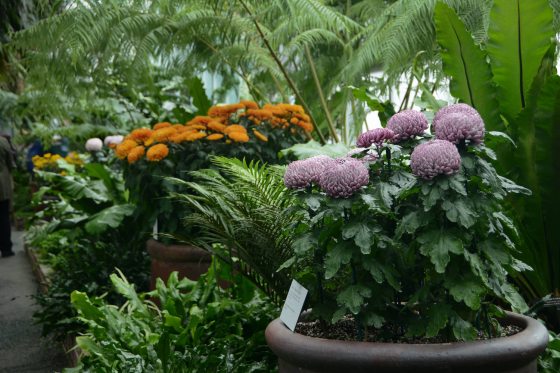
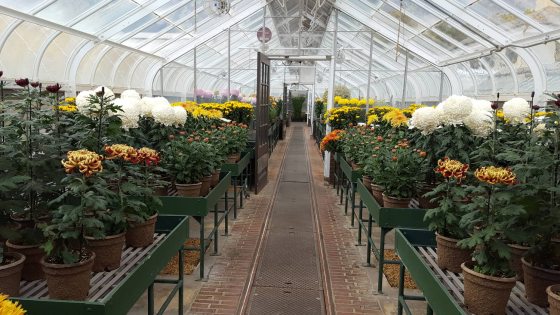
The most iconic part of our Chrysanthemum Festival are the three-dimensional pieces we create using cascade chrysanthemums. These amazing plants can grow six feet in a season, are extremely flexible, can be adapted to many shapes and forms, and produce an abundance of small anemone-type blooms. These mums are also capable of being grown down a metal form, pinched and tied down, and then removed from the frame, brought inside and hung from their pots down the columns. While the other mums are all grown in greenhouses, our cascade mums are grown outdoors, in full sun, by a highly trained team. Most of the three dimensional forms have a metal structure inside of them, fabricated by our in-house welders, to support the plant. Many of these forms are inspired by similar forms we have seen in Japan, but we also create unique forms and are always dreaming up new ways to present chrysanthemums.
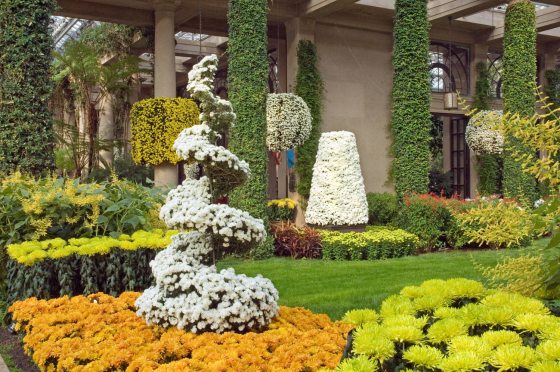
The forms are paramount to adding a level of interest and height to the display. Each year, I move and group the forms on different walkways, depending on the mums I choose for each bed, making sure the colors complement each other. Our chrysanthemum collection contains many more types of bedding mums than cascade mums, which means that we have less color variety in our cascade forms, adding a bit to the challenge. I work closely with the growers to make sure the number of forms does not exceed what they are capable of growing in any given season. The forms are all very labor intensive. While I try to reuse our tried-and-true forms from year to year (like spirals, obelisks, and columns), I am always looking for new forms or shapes to try as a surprise for our guests. This year don’t miss our new mum “swags” draping across the Exhibition Hall stage.
I invite you to visit our Chrysanthemum Festival through November 19, to appreciate the beauty and skill inherent in the display, and to enjoy this showcase of fall’s favorite flower.
